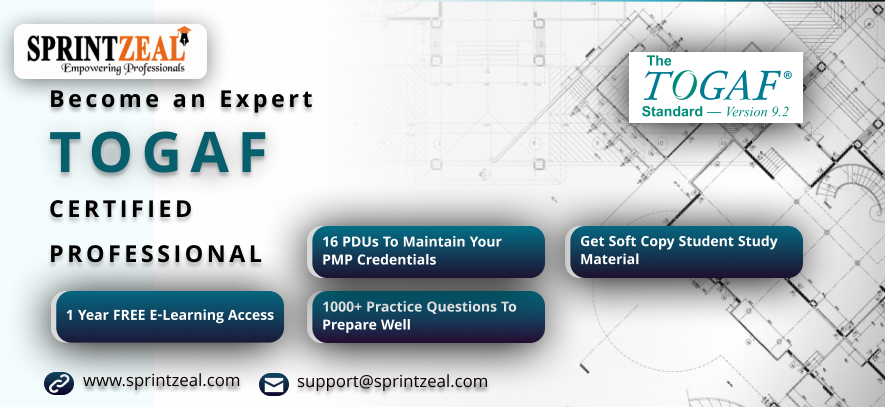In the ever-evolving landscape of enterprise architecture (EA), professionals seek certifications that validate their expertise and enhance their career prospects. The Open Group Architecture Framework (TOGAF) certification is one such credential that has gained prominence in recent years. But amidst the myriad of certifications available, aspiring architects often wonder: Is TOGAF certification truly useful? In this article, we delve into the intricacies of TOGAF, its benefits, criticisms, and its relevance in today’s business world.
Understanding TOGAF:
TOGAF, developed by The Open Group, is a comprehensive framework for designing, planning, implementing, and governing enterprise information technology architecture. It provides a structured approach to organizing and governing EA, aiming to minimize risk, enhance efficiency, and align IT with business goals. TOGAF certification is based on four key components:
-
Architecture Development Method (ADM): This is the core of TOGAF, offering a step-by-step guide to creating and managing enterprise architecture. ADM consists of phases such as architecture vision, business architecture, information systems architecture, technology architecture, and opportunities & solutions, among others.
-
Enterprise Continuum: It acts as a repository of architectural assets, solutions, and industry standards. This continuum helps architects leverage existing knowledge and best practices, accelerating the development of new architectures.
-
TOGAF Reference Models: These models provide generic solutions to common architecture problems, offering a starting point for architects to tailor solutions according to specific organizational needs.
-
TOGAF Resource Base: This encompasses guidelines, templates, and other resources to support architects in their EA endeavors.
The Benefits of TOGAF Certification:
1. Standardization:
TOGAF provides a standardized approach to EA, enabling organizations to communicate effectively across departments and with external stakeholders. Certified TOGAF professionals possess a common language and understanding of architectural concepts, facilitating smoother collaboration and decision-making.
2. Career Advancement:
TOGAF certification enhances career prospects for IT professionals aspiring to work in architecture-related roles. It validates their expertise in EA principles and practices, making them more desirable candidates for architectural positions in various industries.
3. Improved Efficiency:
By following the structured approach prescribed by TOGAF, organizations can streamline their architecture development processes, leading to improved efficiency and resource utilization. Certified architects are equipped with tools and methodologies to design and implement architectures that align with business objectives.
4. Global Recognition:
TOGAF certification is globally recognized, making it valuable for professionals seeking opportunities in multinational corporations or across international markets. It serves as a testament to their proficiency in EA and enhances their credibility in the global job market.
5. Risk Mitigation:
Effective architecture governance, a core tenet of TOGAF, helps organizations mitigate risks associated with IT investments and changes. Certified architects are trained to identify potential risks and develop architectures that address security, compliance, and regulatory requirements.
Criticisms of TOGAF:
Despite its widespread adoption, TOGAF is not without its criticisms. Some common critiques include:
-
Complexity: TOGAF’s comprehensive nature can be overwhelming for beginners, leading to challenges in implementation and adoption.
-
Lack of Flexibility: Critics argue that TOGAF’s prescriptive nature limits creativity and innovation, as it primarily focuses on established best practices and standards.
-
Theoretical Emphasis: Some practitioners contend that TOGAF places too much emphasis on theory rather than practical application, making it less relevant in real-world scenarios.
-
Limited Scope: While TOGAF covers a broad range of architectural domains, it may not address all specialized requirements of certain industries or niche areas of expertise.
The Relevance of TOGAF in Today’s Business Environment:
In an era characterized by digital transformation and rapid technological advancements, the need for effective enterprise architecture has never been greater. TOGAF, with its emphasis on strategic alignment, agility, and governance, remains highly relevant in helping organizations navigate complex IT landscapes and achieve their business objectives.
1. Digital Transformation:
As organizations embark on digital transformation journeys, TOGAF provides a structured approach to aligning IT capabilities with evolving business needs. Certified architects play a crucial role in designing digital-ready architectures that support innovation and growth.
2. Cloud Computing:
The adoption of cloud computing presents both opportunities and challenges for enterprise architects. TOGAF offers guidance on integrating cloud services into existing architectures while ensuring security, scalability, and interoperability.
3. Agile and DevOps Practices:
TOGAF’s flexibility allows organizations to incorporate agile and DevOps practices into their architecture development processes seamlessly. Certified architects are equipped to adapt to changing methodologies and deliver value incrementally.
4. Regulatory Compliance:
With increasing regulatory scrutiny in areas such as data privacy and cybersecurity, TOGAF helps organizations develop architectures that comply with relevant laws and regulations. Certified architects are well-versed in designing secure and resilient systems that protect sensitive information.
Conclusion:
In conclusion, TOGAF certification offers tangible benefits for IT professionals and organizations seeking to excel in enterprise architecture. While it is not without its criticisms, TOGAF’s standardized approach, global recognition, and relevance in today’s business environment make it a valuable credential for aspiring architects and seasoned professionals alike. By mastering TOGAF principles and practices, architects can drive innovation, mitigate risks, and contribute to the strategic success of their organizations in an increasingly complex digital landscape.

